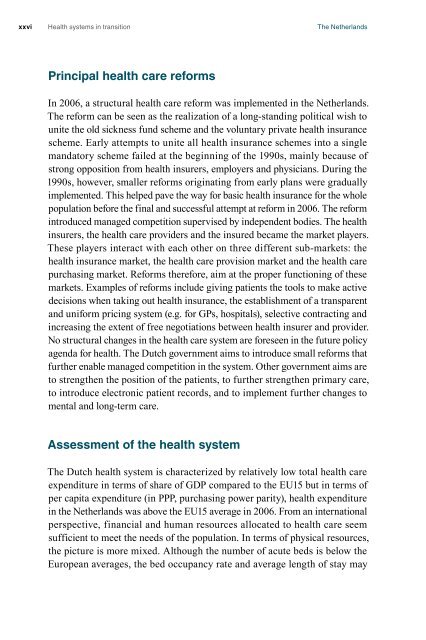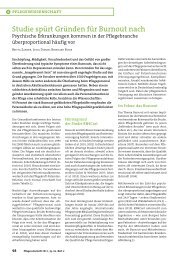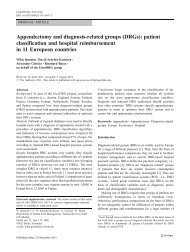The Netherlands: Health System Review 2010
The Netherlands: Health System Review 2010
The Netherlands: Health System Review 2010
Create successful ePaper yourself
Turn your PDF publications into a flip-book with our unique Google optimized e-Paper software.
xxvi<br />
<strong>Health</strong> systems in transition <strong>The</strong> <strong>Netherlands</strong><br />
Principal health care reforms<br />
In 2006, a structural health care reform was implemented in the <strong>Netherlands</strong>.<br />
<strong>The</strong> reform can be seen as the realization of a long-standing political wish to<br />
unite the old sickness fund scheme and the voluntary private health insurance<br />
scheme. Early attempts to unite all health insurance schemes into a single<br />
mandatory scheme failed at the beginning of the 1990s, mainly because of<br />
strong opposition from health insurers, employers and physicians. During the<br />
1990s, however, smaller reforms originating from early plans were gradually<br />
implemented. This helped pave the way for basic health insurance for the whole<br />
population before the final and successful attempt at reform in 2006. <strong>The</strong> reform<br />
introduced managed competition supervised by independent bodies. <strong>The</strong> health<br />
insurers, the health care providers and the insured became the market players.<br />
<strong>The</strong>se players interact with each other on three different sub-markets: the<br />
health insurance market, the health care provision market and the health care<br />
purchasing market. Reforms therefore, aim at the proper functioning of these<br />
markets. Examples of reforms include giving patients the tools to make active<br />
decisions when taking out health insurance, the establishment of a transparent<br />
and uniform pricing system (e.g. for GPs, hospitals), selective contracting and<br />
increasing the extent of free negotiations between health insurer and provider.<br />
No structural changes in the health care system are foreseen in the future policy<br />
agenda for health. <strong>The</strong> Dutch government aims to introduce small reforms that<br />
further enable managed competition in the system. Other government aims are<br />
to strengthen the position of the patients, to further strengthen primary care,<br />
to introduce electronic patient records, and to implement further changes to<br />
mental and long-term care.<br />
Assessment of the health system<br />
<strong>The</strong> Dutch health system is characterized by relatively low total health care<br />
expenditure in terms of share of GDP compared to the EU15 but in terms of<br />
per capita expenditure (in PPP, purchasing power parity), health expenditure<br />
in the <strong>Netherlands</strong> was above the EU15 average in 2006. From an international<br />
perspective, financial and human resources allocated to health care seem<br />
sufficient to meet the needs of the population. In terms of physical resources,<br />
the picture is more mixed. Although the number of acute beds is below the<br />
European averages, the bed occupancy rate and average length of stay may














